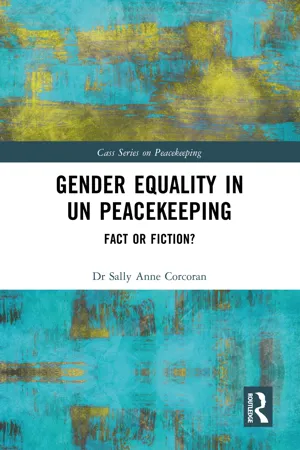
- 244 pages
- English
- ePUB (mobile friendly)
- Available on iOS & Android
About this book
This book investigates to what extent UNSCR 1325/WPS agenda has functioned in practice, to advance women's equality and empowerment in the peacekeeping context and beyond.
The book examines whether widespread implementation of UNSCR 1325 and the broader WPS agenda via gender mainstreaming in UN operations has translated into increased gender equality in peacekeeping operations, the broader UN institutional context and, by extension, the host countries in which missions are situated, via norm dissemination. The book investigates this via a review of the implementation of UNSCR1325 in the operations chosen as research sites over three snapshot years. The book undertakes a comparative analysis that scrutinizes if, how and under what conditions gender mainstreaming has succeeded as a strategy to advance gender equality by analyzing the factors/conditions that have led to successful gender mainstreaming across the operational context, and those that have impeded this outcome. The book concludes that, despite rhetorical commitments to women's equality in peacekeeping since the passage of UNSCR 1325, progress on the ground has remained minimal, and that the operational environment continues to be discriminatory against women. Both quantitatively and qualitatively, women do not participate as equal partners in peacekeeping and continue to have less access to resources and decision-making power, overall. The book interrogates that by exploring the spaces available within law, policy and practice of the UN to pursue the human rights agenda of gender equality and considers whether UNSCR 1325 has enlarged those spaces. It also points to the irony of internal UN structures failing to adequately adapt to their own gender mainstreaming mandates, while those same structures have delivered some gender equality mandates successes externally, at local levels.
This book will be of interest to students of peacekeeping, gender studies, and International Relations.
Frequently asked questions
- Essential is ideal for learners and professionals who enjoy exploring a wide range of subjects. Access the Essential Library with 800,000+ trusted titles and best-sellers across business, personal growth, and the humanities. Includes unlimited reading time and Standard Read Aloud voice.
- Complete: Perfect for advanced learners and researchers needing full, unrestricted access. Unlock 1.4M+ books across hundreds of subjects, including academic and specialized titles. The Complete Plan also includes advanced features like Premium Read Aloud and Research Assistant.
Please note we cannot support devices running on iOS 13 and Android 7 or earlier. Learn more about using the app.
Information
Table of contents
- Cover
- Endorsements
- Series Page
- Half Title
- Title Page
- Copyright Page
- Contents
- Acknowledgments
- 1 Introduction
- 2 Legal and Policy Frameworks for Peace Operations
- 3 An Expression of Feminist Politics and Achievements and Impediments to Implementation: UNSCR 1325: 2000–2021
- 4 Case Studies: Gender in Practice
- 5 Mali: Increase in Women's Participation Brings a More Sustainable Peace
- 6 Lebanon: UN Support Instrumental in Helping to Close the Political Gender Gap
- 7 Timor-Leste: Lasting Gender Equality Gains as an End Result of UN Mission Presence
- 8 Interview Evidence
- 9 Conclusions
- Appendix 1: Summary of Interviews
- Appendix 2: Final Interview Questions
- Bibliography
- Index